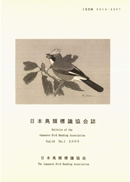All issues

Volume 18 (2005)
- Issue 2 Pages 25-
- Issue 1 Pages 1-
Volume 18, Issue 1
Displaying 1-3 of 3 articles from this issue
- |<
- <
- 1
- >
- >|
-
Michio FUKUDA, Yuuichi KIMURA, Nanae KATO2005Volume 18Issue 1 Pages 1-8
Published: 2005
Released on J-STAGE: August 20, 2015
JOURNAL FREE ACCESSNumber of eggs per nest was researched for nests of Great Cormorant Phalacrocorax carbo, at a colony located near the mouth of the Obitsu River, in Chiba Prefecture, Japan. The research was implemented five times from 1999 through 2002. The colony was formed on a small island separated from the mainland by about 15 meters of open water. As there are very few trees, the nestswere laid out among ground vegetation.
Number of eggs per nest ranged from 1-5 eggs. The most number of eggs was 3 (37.9%), followed by 4 (13.8%). The mean number of eggs per nest for all researched nests was 2.46±0.98 (n=298). In Japan, some Great Cormorant colonies show a significant difference in the number of eggs per individual nest, while others do not. In this research, the number of eggs per nest was significantly different, and the clutch size in individual nests also differed over time, with a tendency for clutch size to be larger in the early breeding season and smaller later on.View full abstractDownload PDF (1437K) -
Junko HIROKAWA, Tsuyoshi HAMADA, Takashiro HIGUCHI2005Volume 18Issue 1 Pages 9-15
Published: 2005
Released on J-STAGE: August 20, 2015
JOURNAL FREE ACCESSDetermination of Fat Score and measurement of body weight were implemented for 282 individuals of Black-faced Bunting Emberiza spodocephala. The research was undertaken from May through October of 2002, at Ishikari City, along the Japan Sea side of Hokkaido, Japan. Fat score was assigned in 9 values, from 0 the lowest to 8 the highest. The results showed low values for fat deposition during the breeding season (May-Aug) and moulting season (Sept), but higher values for the migration season (Oct). The individuals captured during the migratory season were thought to be mainly birds that had just migrated into the study area from points further north. Even during the migration season, however, there were no individuals with fat scores of 4 or over, indicating that this species, at least during the overland portion of their journey, most likely migrates southwards in short movements interspersed with periods of fat acquisition. The data also showed a significant difference in body weight for individuals with identical fat scores. A difference in fat score of at least 2 values was required to produce a significant difference in body weight.View full abstractDownload PDF (1193K)
-
Tatsuo KAZAMA2005Volume 18Issue 1 Pages 16-19
Published: 2005
Released on J-STAGE: August 20, 2015
JOURNAL FREE ACCESSOver the past several decades, widespread road construction in Japan has resulted in an increase in birds being killed by collisions with vehicles. In addition, during more recent years a spurt in construction of high rise buildings has also contributed to bird deaths through collisions. Based on 45 years of data, it can be estimated than an average of 100,000 birds are killed in Japan each year by collisions with vehicles, structures and utility lines and poles. The carcasses of these birds can be utilized to obtain scientific data for research, as well as for specimens to be used in environmental education. Various body measurements can be taken, and the birds can be analyzed for stomach contents, parasites and environmental chemicals such as dioxins. Preservation can be by formalin or stuffing. If stuffing is difficult, the feathers can be preserved as specimens for use in museums, schools and other education programs.View full abstractDownload PDF (626K)
- |<
- <
- 1
- >
- >|